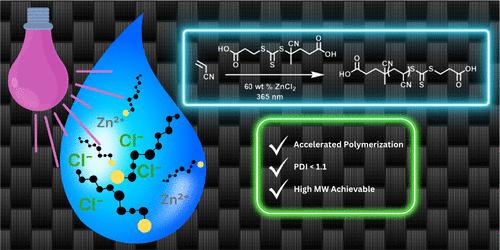当前位置:
X-MOL 学术
›
ACS Macro Lett.
›
论文详情
Our official English website, www.x-mol.net, welcomes your
feedback! (Note: you will need to create a separate account there.)
Aqueous Photoiniferter Polymerization of Acrylonitrile
ACS Macro Letters ( IF 5.1 ) Pub Date : 2024-11-19 , DOI: 10.1021/acsmacrolett.4c00642 Evan K. Stacy, Mac L. McCormick, Kaden C. Stevens, Penelope E. Jankoski, Jeff Aguinaga, Derek L. Patton, Brent S. Sumerlin, Tristan D. Clemons
ACS Macro Letters ( IF 5.1 ) Pub Date : 2024-11-19 , DOI: 10.1021/acsmacrolett.4c00642 Evan K. Stacy, Mac L. McCormick, Kaden C. Stevens, Penelope E. Jankoski, Jeff Aguinaga, Derek L. Patton, Brent S. Sumerlin, Tristan D. Clemons

|
Polyacrylonitrile (PAN) is a key industrial polymer for the production of carbon fiber for high-strength, lightweight composite material applications, with an estimated 90% of the carbon fiber market relying on PAN-based polymers. Traditionally, PAN synthesis is achieved by conventional radical polymerization, resulting in broad molecular weight distributions and the use of toxic organic solvents or surfactants during the synthesis. Additionally, attempts to improve polymer and processing properties by controlled radical polymerization methods suffer from low monomer conversions and struggle to achieve molecular weights suitable for producing high-performance carbon fiber. In this study, we present an aqueous photoiniferter (aqPI) polymerization of acrylonitrile, achieving high monomer conversion and high PAN molecular weights with significantly faster kinetics and dispersity control when compared to traditional methods. This approach allows for the unprecedented control of polymer properties that are integral for downstream processing for enhanced carbon fiber production.
中文翻译:

丙烯腈的水性光离子聚合物聚合
聚丙烯腈 (PAN) 是生产高强度、轻质复合材料用碳纤维的关键工业聚合物,估计 90% 的碳纤维市场依赖于基于 PAN 的聚合物。传统上,PAN 合成是通过常规自由基聚合实现的,导致分子量分布较宽,并且在合成过程中使用有毒有机溶剂或表面活性剂。此外,通过受控自由基聚合方法改善聚合物和加工性能的尝试存在单体转化率低的问题,并且难以获得适合生产高性能碳纤维的分子量。在这项研究中,我们提出了一种丙烯腈的水性光离子干扰剂 (aqPI) 聚合,与传统方法相比,实现了高单体转化率和高 PAN 分子量,动力学和分散性控制明显更快。这种方法可以对聚合物特性进行前所未有的控制,这些特性对于下游加工以提高碳纤维生产是不可或缺的。
更新日期:2024-11-19
中文翻译:

丙烯腈的水性光离子聚合物聚合
聚丙烯腈 (PAN) 是生产高强度、轻质复合材料用碳纤维的关键工业聚合物,估计 90% 的碳纤维市场依赖于基于 PAN 的聚合物。传统上,PAN 合成是通过常规自由基聚合实现的,导致分子量分布较宽,并且在合成过程中使用有毒有机溶剂或表面活性剂。此外,通过受控自由基聚合方法改善聚合物和加工性能的尝试存在单体转化率低的问题,并且难以获得适合生产高性能碳纤维的分子量。在这项研究中,我们提出了一种丙烯腈的水性光离子干扰剂 (aqPI) 聚合,与传统方法相比,实现了高单体转化率和高 PAN 分子量,动力学和分散性控制明显更快。这种方法可以对聚合物特性进行前所未有的控制,这些特性对于下游加工以提高碳纤维生产是不可或缺的。






























 京公网安备 11010802027423号
京公网安备 11010802027423号